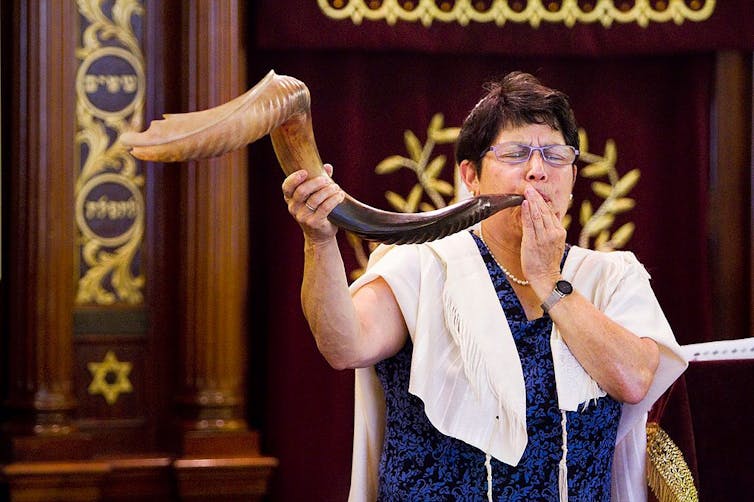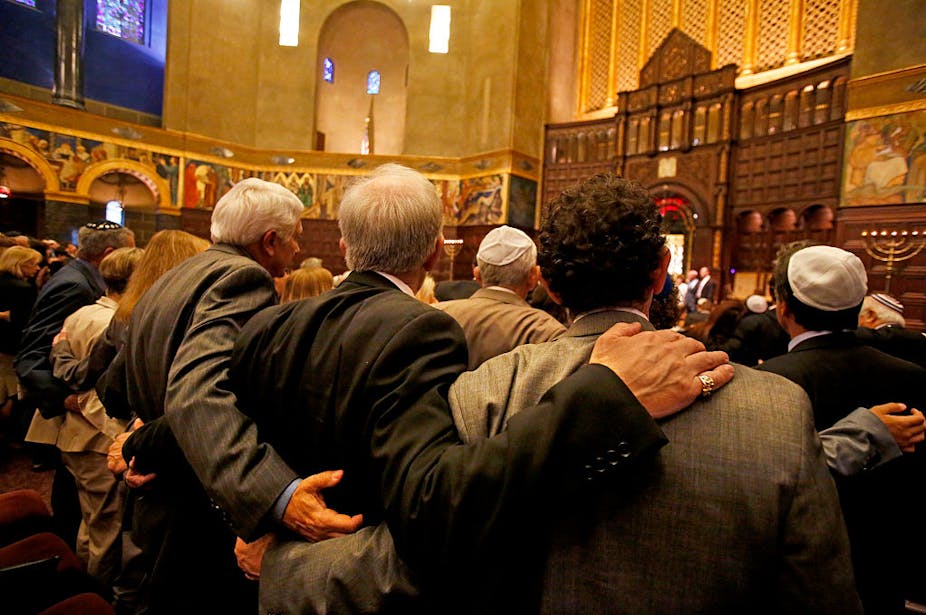Starting the evening of Sept. 15, 2023, and again the evening of Sept. 24, Jews around the world will be filing into synagogues to mark their “Days of Awe” – the High Holidays of Rosh Hashana and Yom Kippur.
For many who observe these holidays in the United States, the Days of Awe will be the only time that they visit a synagogue this year. Only 1 in 5 American Jews attend services once a month or more.
What is more, Yom Kippur is among the most somber and punishing holidays of the Jewish calendar. Why, then, do so many individuals who rarely pray in a synagogue choose to do it during the dour Days of Awe, rather than on many of the joyful, celebratory feasts that the Jewish calendar has to offer?
The answer lies partly in the nature of Jewish civilization itself. While today observers perceive Judaism as a religion, Jewish culture is not focused on individual belief and worship so much as on an entire community and its collective relationship with God and its history.
As a scholar of Judaic studies, I believe these are core, galvanizing elements of Jewish civilization that the Days of Awe bring into relief, making the High Holy Days a focus of congregants’ cultural lives as Jews. While the High Holidays may seem like days of individual soul-searching and repentance alone, their focus is actually communal, taking stock of an entire people’s identity and traditions.
Rosh Hashana: The Jewish New Year
According to rabbinic interpretations, Rosh Hashana commemorates God’s creation of humanity. Tradition has it that Rosh Hashana is a time when God judges humans, and especially “his people,” Israel. Meanwhile, they affirm their acceptance of God’s sovereignty over everything and everybody.
That is largely why Jews exchange New Year’s greetings along the lines of, “May you be inscribed [in the Book of Life]” – folkloric shorthand for wishing someone a good fate for the year ahead.

Whether they occur in traditionalist or modernist settings, Jewish New Year ceremonies are mostly held in synagogues. The services begin with attendees’ recitation of an ancient liturgy that underscores God’s kingship over the universe. Yet the centerpiece is the loud blowing of a shofar, a ram’s horn, whose powerful blasts the biblical book of Joshua describes as bringing down the walls of the city of Jericho. During the High Holidays, the sound “opens the gates of heaven” so that congregants’ acknowledgment of divine sovereignty can enter God’s abode and inform his judgment.
Notably, Jewish law has it that individuals should not mark the High Holidays alone. Ideally, the services require a “minyan,” or quorum of 10 adults – as do many Jewish rituals.
Before 70 C.E., when Roman legions destroyed the Jerusalem Temple, sacrifices at its altar were an important component of Jewish social, political and ritual life. Afterward, rabbinic law radically democratized the Israelites’ rituals, mostly as liturgical services. These took the place of activities that the priests of the temple had performed. Thus the people, along with their history as a political community, remained the protagonists of a comprehensive cultural system – not the relatively narrow, private sense of “faith” that the word “religion” can suggest.
Confession – as a community – on Yom Kippur
After Rosh Hashana, the mood darkens as Yom Kippur approaches: the Day of Atonement.
On the eve of Yom Kippur, before its onset at sundown, Jews return to their synagogues. As a prelude to the first Yom Kippur service, a cantor or another skilled congregant sings the famed Kol Nidre: the Renunciation of All Vows. This poem asks God to preemptively annul any oaths Jews will make to God unknowingly or involuntarily, or ones they cannot fulfill. Notably, Kol Nidre plaintively asks, “May all the people of Israel be forgiven, including all the strangers who live in their midst, for all the people are at fault.”
One of the Yom Kippur liturgy’s distinctive elements is a section called the Viddui – the “confession.” That word may summon images of a one-on-one encounter with a priest in the privacy of a small, partitioned booth. “Confession” may also suggest a creed: “I believe in X, Y, Z – and that my belief will save my soul.”
Yet Jewish “confession” is neither an affirmation of faith nor a purely individual mea culpa. Instead, the Viddui affirms a long list of wrongdoings for which all congregants repent: Among other things, “We and our fathers have sinned. We have trespassed. We have betrayed; We have stolen. We have slandered.”
The focus of the services, in other words, is not exclusively on personal sin and salvation. The language of the liturgy uses “we,” not just “I.” It does not matter whether individuals reciting the liturgy have erred in the specific ways the confession mentions. What matters is that they take responsibility for the entire Jewish people – past, present and future – in relation to their fellow humans, and in relation to the God of Israel: One for all, and all for one.
As the Talmud puts it, “All Israel [is] mutually responsible.” The biblical Book of Deuteronomy, too, is packed with laws for the entire people of Israel as they are about to enter their promised land, so that they “may prolong your days upon the land.” Commandments about theft, mercy and caring for the stranger and the orphan, for example, are explicit blueprints for a functioning, socially just state – not just guides to individual or universal morality.
The books of the Hebrew Bible enshrine a story of the Jewish people, a collective story at the root of these awe-filled days. Indeed, the High Holidays affirm a sense of belonging that keeps even some of the least traditional Jews returning to ceremonies every year, affirming the ideal of a kinship-based society rooted in collective justice.

